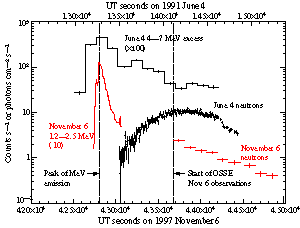Back To OSSE Solar Flare Web Page
1997 November 06 (X4.9)
A GOES X9.4 solar flare occurred on 1997 November 6 at an H-alpha location of S18W63 (heliographic coordinates). The soft X-ray flux began at 11:22 (40920 s), peaked at 11:56 (42960 s), and ended at 12:44 (45840 s) UT (GOES Geophysical Data Web Site). The flare was well-observed by the detectors on board the Yohkoh satellite but CGRO was shut down for an SAA transit during the peak of the gamma-ray emission. CGRO emerged from the SAA at 12:07 (43620) UT (approximately 800 seconds after the peak of the flare) observing 3C390.3 with a standard 2-min on-off chopping strategy. No BATSE trigger was received so the four detectors continued observing 3C390.3 with the Sun ~80 degrees off the detector axes. Observations continued until satellite night at about 12:28 (44905 s) UT.
OSSE detected no gamma-ray emission at this late time in the flare but did observe high-energy neutrons. The OSSE neutron count rate time profile is shown in Figure 1 along with the 1.2-2.5 MeV gamma-ray emission observed with the WBS on Yohkoh. Also shown are the neutron and 4-7 MeV gamma-rays from the 1991 June 4 flare observed with OSSE. The time axes of the two flares have been shifted so that the peaks of the ~MeV emissions coincide. The gamma-ray emission from the November 6 flare was more impulsive than that from the June 4 flare. Also, the November 6 neutron time profile fell much more rapidly the that of June 4. This suggests that the spectrum of the neutrons escaping from the Sun was harder in the November 6 flare than in the June 4 flare.
 Figure 1 |